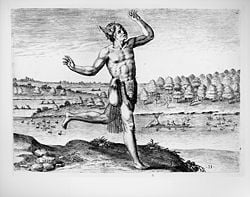Conjuration

The word conjuration (from Latin 'conjuratio', 'conjurare', to swear together) can be interpreted in several different ways: as an invocation or evocation (the latter in the sense of binding by a vow); as an exorcism; or as an act of illusionism. The word is often used synonymously with "invocation," although the two are not synonyms. One who performs conjurations is called a conjurer or conjuror.
Rituals and equipment
As an evocation, a conjuration is the act of summoning one or more spirits with a predetermined purpose by means of a charm. This typically means that the conjurer will perform some ritual to call upon the spirit.
Some conjurations have as a requisite a previous ritual of purification of body, mind and soul to attract the spirit or avoid the danger this entity could represent.
Some think that for a better result the conjurer must wear special clothes and/or ornaments, and amulets for attraction and/or protection. Magic symbols drawn on the floor and/or altar and embroidered on the clothes are often used, having each one a specific purpose. The hour of the day or night and the planetary aspects (astrological configuration of the zodiac) are considered important, depending on the purpose of the conjuration.
A special atmosphere is generally preferred in the room or place in which the ritual is going to be performed, using specific aromatic resins and herbs (incense, myrrh, etc.), and lighting the place with candles or torches if possible.
Texts and language
The text of the charms to be recited to conjure the spirit varies considerably from simple sentences to complex paragraphs with plenty of magic words. The language usually is that of the conjurer's, but since the Middle Ages in Western tradition, Latin was the most common (although many texts have been translated into other languages).
Objectives of conjuration
The conjuration of the ghosts or souls of the dead for the purpose of divination is called necromancy.
When it is said that a person is calling upon or conjuring misfortune or disease, it is due to the ancient belief that personified diseases and misfortune as evil deities, spirits or demons that could enter a human or animal body; see demon possession.
Religious reactions
It is traditionally believed by many, particularly in Christian societies, that magic, and thus conjuration, is an inherently evil practice. According to these beliefs, conjurers summon demons or other evil spirits to cause harm to people or things, to obtain favours from them, or simply to enter servitude to such beings. The belief in similarly-minded conjurers also exists in belief systems in which magic is not inherently evil, although in these cultures these "black magicians" are not the rule and have opposition among more traditional magicians.
Contemporary references
"Conjurer" or "conjuror" is still the term for what is today called an illusionist or magician by its practitioners. In the not too distant past, conjurors where suspected of being capable of using magic power to create their entertaining illusions and even cast spells. Thus they became "magicians" to the general public, who were superstitious, anxious, ill-informed and uncurious.
See also
ReferencesISBN links support NWE through referral fees
Credits
New World Encyclopedia writers and editors rewrote and completed the Wikipedia article in accordance with New World Encyclopedia standards. This article abides by terms of the Creative Commons CC-by-sa 3.0 License (CC-by-sa), which may be used and disseminated with proper attribution. Credit is due under the terms of this license that can reference both the New World Encyclopedia contributors and the selfless volunteer contributors of the Wikimedia Foundation. To cite this article click here for a list of acceptable citing formats.The history of earlier contributions by wikipedians is accessible to researchers here:
The history of this article since it was imported to New World Encyclopedia:
Note: Some restrictions may apply to use of individual images which are separately licensed.